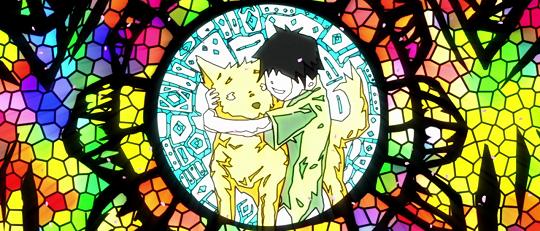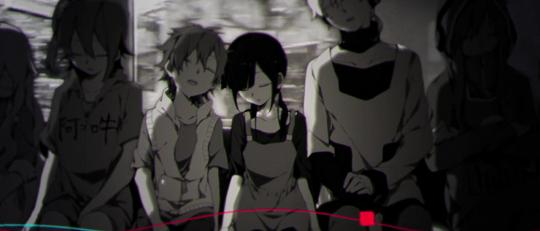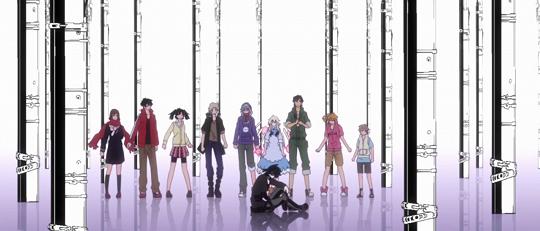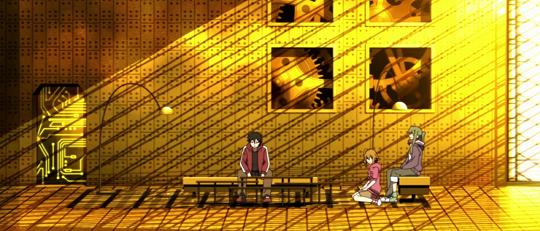The elephant in the room whenever I’m talking about a series like Monogatari, ef, Sasami-san@Ganbaranai or, in this case, Mekakucity Actors, is the director Akiyuki Shinbo. I have tried and usually failed to address that elephant when reviewing his shows yet each one he does without sharing directing duties is indelibly stamped with his unique vision. My issue being that despite his obvious talent and corruscating view of the world, it takes an enormously strong story to match that style. Mekakucity Actors does not have that.
Madoka did which is why it’s difficult not to maintain the niggling suspicion that it was so successful despite the director rather than because of him. He is consistently strong when it comes to aesthetics, with allegories and metaphors bubbling contentedly beneath the surface but with Mekaku it’s nothing we haven’t seen before. There’s the fascination with time and cogs with crooked clock towers and giant hourglasses littering the landscape and drenched in neon like a futuristic Salvador Dali. Sunsets and stained glass windows frame moody looking teenagers holding books and cocking their heads with signature aloofness.
And I have no idea what’s going on.
More critically than that though is that I don’t particularly care to find out what’s going on. That may sound like the cop-out from an apathetic dunce but none of the characters, none of the plot points, none of the fantasy leanings or technological trappings incline me to piece together the disjointed story of teenagers with special powers.
I can tell you the broad strokes of course: adolescents, red eyes, Durarara style gang, snakes (hello Monogatari S2) death and sadness. What I can’t do though is tell you about the terrorists that, for some reason, attack a mall in the opening story arc and whether they have anything to do with the plot as a whole. Same too for the little boy trapped in a time loop or the albino-esque automaton wandering the streets.
It starts off promisingly enough with a pseudo-hikkikomori forced to venture outside with his on-screen assistant Ene who is an obnoxious mash-up of a vocaloid and the Microsoft Word paperclip. Vocaloids is where this all originated from though with the cross-media releases of the Kagerou Project that mixed light novels, vocaloid soundtracks and NicoNico hosted music videos. At least that’s what I gather from the Wikipedia page when I researched why people referred to the series with the short name Kagepro.
As I mentioned in my Sasami-san@Ganbaranai review, it’s hard not to feel like a curmudgeonly old man when criticising the baffling nature of the series, as if a youth and exuberance that matches the technicolour presentation will somehow paper over the flat, piecemeal storytelling. The series is fascinating to watch but the brutal chopping and reassembling of the narrative, leaping between characters, timelines and styles is exhausting and, yes, confusing. So from the start with the hikkikomori and his digital pocket girlfriend it leaps to his sister, both of whom are connected by the Blindfold gang, the members of which share a past together, but one of whom has an even darker past that is narrated as storybook collage style addendums to the main episodes. That’s after the credits but before the weird dual ending illustrations.
It’s a lot like someone turned Shinbo upside down, shook him, and whatever fell out they just fired scattershot at the animators. The interlocking of the different timelines and characters should gel a lot better than it does and yet the children that we see in the past, if it wasn’t for their obvious visual similarities, seem to bear no personality resemblance to the teenagers we see in the present. Despite all of this though - the abstract direction, the detached heartache, the disjointed chronology - the story feels vaguely familiar; there are traces of so many other different stories in there that the whole is original but the parts are so close to recognisable. Is that a hint of RahXephon in there? Perhaps.
I have yet to fall in love with a series that Akiyuki Shinbo has directed and Mekakucity Actors is another data point towards the reasoning as to why. The first time you watch one of his series - because they are his series moreso than any other anime director - it’s intoxicating to see the breadth of imagination and technical mastery he displays. A few series and a few years later though and it all just feels a bit rote. Oh look, more use of shadows and silhouettes; two and three tone colour schemes? sure; head-tilt; cinemascope letterboxing, someone wants to go back to movies; janky CG opening animation? actually haven’t seen that before. Increasingly it feels as though the director is more interested in championing his inimitable style rather than letting the story and its minutiae breathe.
As before then, it’s an interesting series to watch and I maintain a respectful reverence for the obvious talent on display but with the caveat that despite the director’s often minimalist aesthetic, sometimes less of that would give the series a lot more.












